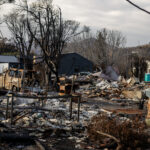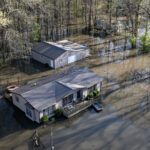Floods caused billions of dollars in losses and dominated the natural catastrophe statistics for the first half of 2013, according to a study released by Munich Re. “Around 47 percent of the overall losses and 45 percent of the insured losses derived from inland flooding that occurred in Europe, Canada, Asia and Australia.”
The report points out, however, that at “around $45 billion, losses from natural catastrophes were below the average amount for the past ten years ($85 billion). Insured losses totaled approximately $13 billon (ten-year average: $22 billion).”
By a large margin the most expensive natural catastrophe in the first half-year was in Munich Re’s back yard, where flooding in southern and eastern Germany and other eastern and Central European countries in May and June resulted in “an overall loss of more than €12 billion [$15.5 billion – at current rates] and an insured loss in the region of €3 billion plus ($3.9 billion). The majority of the insured losses occurred in Germany. By way of comparison, the Elbe flooding in 2002 caused an overall economic loss of $16.5 billion, of which $3.4 billion was insured.”
Munich Re Board member Torsten Jeworrek said: “The frequency of flood events in Germany and central Europe has increased by a factor of two since 1980. But particularly with floods, an increased hazard – such as more frequent heavy rainfall events – need not necessarily result in higher losses. Such a rise in losses can be prevented by better flood control.
“It is therefore important to sharpen risk awareness. Rivers need room so that flood waves can disperse without causing serious damage. And the flood risk needs to be considered in the designation of land for industrial or residential areas. Politicians should not only set up emergency funds after catastrophes but should act with greater foresight, engaging in prudent supra-regional flood control, which should ideally be coordinated across national borders.”
The report explained that the “flooding in Germany and the neighboring countries to the east was caused by an atmospheric trough across central Europe, drawing moist air from the Mediterranean and southeast European area northwards over Eastern Europe. The lows embedded in this air current, with an anticlockwise airstream, led to orographic lifting on the north sides of the eastern German mountain ranges and the Alps.
“In some places, 400 liters [app.100 gallons] of rain per square meter [app.10 square feet] fell within a few days. And up to 100 liters [app 25 gallons per square meter were recorded over a very large area. As the ground was already saturated from the rainiest spring for 50 years, the rainwater flowed directly into the rivers.”
As a result there were extensive floods in Bavaria and eastern Germany, “which significantly exceeded the levels of 2002 in many places on the Danube and Elbe. In Passau, at the confluence of the rivers Danube, Inn and Ilz, the highest water level since 1501 was recorded. In Dresden, by contrast, the old city center was largely spared, unlike in 2002. Thanks to better flood control, fewer dykes on the upper reaches of the Elbe broke than in 2002, but this meant that the flood wave further downstream was all the higher. In Magdeburg, the floods reached a record level. More than 20,000 people had to be evacuated.
“In neighboring countries like the Czech Republic and Austria, the flooding also caused high losses, although in contrast to 2002 the old city center of the Czech capital Prague escaped largely unscathed, thanks to enhanced flood control measures. Austria experienced numerous mudflows as a result of the heavy rain. In Vienna, some of the floodwater was diverted into the “New Danube” relief canal, enabling the flooding to be restricted to a few streets. The floods in Slovakia and Hungary were limited to the swollen Danube, as the two countries themselves were not affected by the heavy rain. In Bratislava and Budapest, the flood control measures proved their worth, with only a few streets right next to the river being flooded.”
Prof. Peter Höppe, Head of Munich Re’s Geo Risks Research unit, noted: “It is evident that days with weather conditions that lead to such flooding are becoming more frequent and that such weather systems tend to remain stationary for longer. With this higher persistence of weather patterns, the potential for heavy and long-lasting precipitation within a trough situation, for example, increases. The counterparts to this are stationary high-pressure systems which in summer increase the risk of heat waves and periods of drought.
“Debate in climate research is currently focusing on what the causes of such changes in weather patterns could be and what role climate change might play in this. But it is naturally not possible to explain single events on this basis,” he added.
The series of tornadoes that struck a number of U.S. states between the 18th and the 22nd of May were the second most expensive loss event in the first half of the year. The tornado that formed on the 21st of May was a category 5, the highest strength measured. It hit the town of Moore, a suburb of Oklahoma City, “with peak wind speeds of up to 300 km [188 mph] per hour and was unusually large, with a width of nearly two kilometers [1.25 miles]. The destruction was enormous: well over 1,000 buildings were completely destroyed in Moore alone, including seven schools and a hospital. 26 people were killed and more than 370 were injured. The overall economic loss amounted to more than US$ 3 billion, of which approximately US$ 1.5 billion was insured.”
Höppe said: “The central states of the USA have the highest tornado risk in the world. Altogether, however, the US tornado season has been below average so far: by the end of June, 625 tornadoes had occurred, compared with the longer-term average of 1,075.”
Munich Re described the floods in the Canadian province of Alberta as “probably the worst flooding ever experienced there.” They began on the 19th of June, when “massive rainfall of up to 200 liters [50 gallons] per square meter in one day coincided with late snowmelt, causing the Bow River in Calgary to swell to a level three times higher than during the flood of 2005.
“Some 75,000 people were evacuated. Numerous streets were flooded, and the Saddledome, home to ice-hockey club Calgary Flames, was hit. Initial estimates indicate an overall economic loss of more than US$ 3 billion, while the insurance loss is likely to exceed the one-billion-dollar mark.”
In terms of loss of life the event with the severest consequences was a “disaster caused by flash floods in northern India and Nepal as a consequence of exceptionally early and extremely heavy monsoon rains. Hundreds of roads and bridges were washed away, making the job of rescue workers all the more difficult. Over 1,000 people were killed.
“All in all, 460 loss-relevant natural hazard events occurred throughout the world in the first half of the year, slightly above the average for the past ten years (390).”
Source: Munich Re
Topics Catastrophe USA Profit Loss Europe Flood
Was this article valuable?
Here are more articles you may enjoy.


 California Again Delays Wildfire Protection Rules for Homes
California Again Delays Wildfire Protection Rules for Homes  Trump to Issue Order Creating National AI Rule
Trump to Issue Order Creating National AI Rule  Hartford: 10-Year Analysis Shows Shifts in Common, Expensive Small-Business Claims
Hartford: 10-Year Analysis Shows Shifts in Common, Expensive Small-Business Claims  Zillow Deleting Home Climate Risk Scores Reveals Limits of Flood, Fire Data
Zillow Deleting Home Climate Risk Scores Reveals Limits of Flood, Fire Data 

